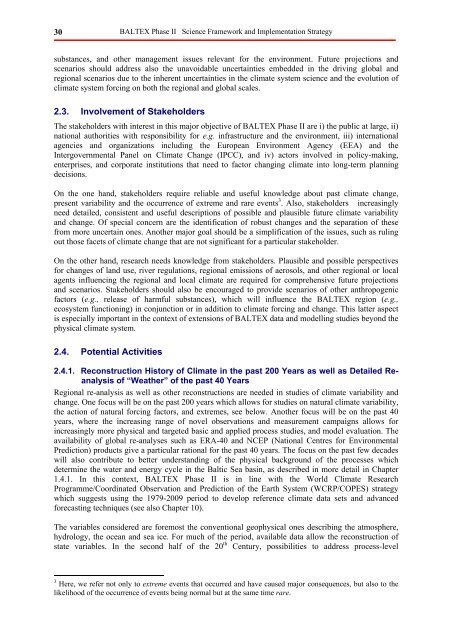BALTEX Phase II 2003 â 2012. Science Framework and ...
BALTEX Phase II 2003 â 2012. Science Framework and ...
BALTEX Phase II 2003 â 2012. Science Framework and ...
Create successful ePaper yourself
Turn your PDF publications into a flip-book with our unique Google optimized e-Paper software.
30<br />
<strong>BALTEX</strong> <strong>Phase</strong> <strong>II</strong> <strong>Science</strong> <strong>Framework</strong> <strong>and</strong> Implementation Strategy<br />
substances, <strong>and</strong> other management issues relevant for the environment. Future projections <strong>and</strong><br />
scenarios should address also the unavoidable uncertainties embedded in the driving global <strong>and</strong><br />
regional scenarios due to the inherent uncertainties in the climate system science <strong>and</strong> the evolution of<br />
climate system forcing on both the regional <strong>and</strong> global scales.<br />
2.3. Involvement of Stakeholders<br />
The stakeholders with interest in this major objective of <strong>BALTEX</strong> <strong>Phase</strong> <strong>II</strong> are i) the public at large, ii)<br />
national authorities with responsibility for e.g. infrastructure <strong>and</strong> the environment, iii) international<br />
agencies <strong>and</strong> organizations including the European Environment Agency (EEA) <strong>and</strong> the<br />
Intergovernmental Panel on Climate Change (IPCC), <strong>and</strong> iv) actors involved in policy-making,<br />
enterprises, <strong>and</strong> corporate institutions that need to factor changing climate into long-term planning<br />
decisions.<br />
On the one h<strong>and</strong>, stakeholders require reliable <strong>and</strong> useful knowledge about past climate change,<br />
present variability <strong>and</strong> the occurrence of extreme <strong>and</strong> rare events 3 . Also, stakeholders increasingly<br />
need detailed, consistent <strong>and</strong> useful descriptions of possible <strong>and</strong> plausible future climate variability<br />
<strong>and</strong> change. Of special concern are the identification of robust changes <strong>and</strong> the separation of these<br />
from more uncertain ones. Another major goal should be a simplification of the issues, such as ruling<br />
out those facets of climate change that are not significant for a particular stakeholder.<br />
On the other h<strong>and</strong>, research needs knowledge from stakeholders. Plausible <strong>and</strong> possible perspectives<br />
for changes of l<strong>and</strong> use, river regulations, regional emissions of aerosols, <strong>and</strong> other regional or local<br />
agents influencing the regional <strong>and</strong> local climate are required for comprehensive future projections<br />
<strong>and</strong> scenarios. Stakeholders should also be encouraged to provide scenarios of other anthropogenic<br />
factors (e.g., release of harmful substances), which will influence the <strong>BALTEX</strong> region (e.g.,<br />
ecosystem functioning) in conjunction or in addition to climate forcing <strong>and</strong> change. This latter aspect<br />
is especially important in the context of extensions of <strong>BALTEX</strong> data <strong>and</strong> modelling studies beyond the<br />
physical climate system.<br />
2.4. Potential Activities<br />
2.4.1. Reconstruction History of Climate in the past 200 Years as well as Detailed Reanalysis<br />
of “Weather” of the past 40 Years<br />
Regional re-analysis as well as other reconstructions are needed in studies of climate variability <strong>and</strong><br />
change. One focus will be on the past 200 years which allows for studies on natural climate variability,<br />
the action of natural forcing factors, <strong>and</strong> extremes, see below. Another focus will be on the past 40<br />
years, where the increasing range of novel observations <strong>and</strong> measurement campaigns allows for<br />
increasingly more physical <strong>and</strong> targeted basic <strong>and</strong> applied process studies, <strong>and</strong> model evaluation. The<br />
availability of global re-analyses such as ERA-40 <strong>and</strong> NCEP (National Centres for Environmental<br />
Prediction) products give a particular rational for the past 40 years. The focus on the past few decades<br />
will also contribute to better underst<strong>and</strong>ing of the physical background of the processes which<br />
determine the water <strong>and</strong> energy cycle in the Baltic Sea basin, as described in more detail in Chapter<br />
1.4.1. In this context, <strong>BALTEX</strong> <strong>Phase</strong> <strong>II</strong> is in line with the World Climate Research<br />
Programme/Coordinated Observation <strong>and</strong> Prediction of the Earth System (WCRP/COPES) strategy<br />
which suggests using the 1979-2009 period to develop reference climate data sets <strong>and</strong> advanced<br />
forecasting techniques (see also Chapter 10).<br />
The variables considered are foremost the conventional geophysical ones describing the atmosphere,<br />
hydrology, the ocean <strong>and</strong> sea ice. For much of the period, available data allow the reconstruction of<br />
state variables. In the second half of the 20 th Century, possibilities to address process-level<br />
3 Here, we refer not only to extreme events that occurred <strong>and</strong> have caused major consequences, but also to the<br />
likelihood of the occurrence of events being normal but at the same time rare.













